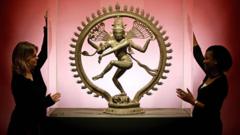In the 11th century, amid a world in flux, one of India's most influential dynasties, the Cholas, rose to prominence, crafting a legacy of innovation, conquest, and cultural transformation. Central to this dynasty's legacy was the monumental Brihadishvara temple, erected under the reign of King Rajaraja Chola. This Unesco World Heritage site, built from 130,000 tonnes of granite, soars to 66 meters and houses a stunning 12-foot statue of the Hindu god Shiva enveloped in gold and precious stones.
While Europe was still in the throes of its Middle Ages, the Chola dynasty showcased an extraordinary capacity for innovation and cultural development. Chola queens, like the dowager Sembiyan Mahadevi, played a vital role in the cultural rebranding of the dynasty, promoting Shiva through stunning temple arts and architecture. These temples became a symbol of the dynasty's devotion, particularly the form of Nataraja, which has since evolved into an iconic symbol of Hinduism.
King Rajaraja Chola expanded his influence beyond India, establishing the first lasting foothold from India on the island of Lanka and seizing territories in the Deccan Plateau. His conquests allowed for the lavish construction of the Brihadishvara temple, which served as a community hub, channeling the empire's resources into public works and agriculture. This monument was a feat of economic ingenuity, with plentiful rice supplies sustaining its operations.
The Chola dynasty was instrumental in fostering economic links across the Indian Ocean. Rajendra Chola furthered these connections, allying with Tamil merchant groups to create trade networks reminiscent of later colonial structures. Under Chola rule, Tamil merchants extended their reach throughout Southeast Asia, establishing ports from Sumatra to Myanmar and even influencing commerce in China under Mongol rule.
The cultural landscape of south India flourished during the Chola era, creating vibrant communities of diverse faiths and ethnicities. With temples as cultural centers, the Tamil population thrived in trade and arts, producing exquisite metalworks and inspiring literature that rivaled European contemporaries. During this renaissance prior to the European equivalent, the Chola period stood out with its artistic brilliance, fostering the creation of renowned bronze sculptures like Nataraja.
Today, remnants of this glittering era can be found in major museum collections worldwide. The Chola dynasty's contributions to global commerce, cultural exchange, and architectural grandeur remain a testament to their significant yet often overlooked role in shaping history. Anirudh Kanisetti, an author and historian, seeks to highlight these rich narratives, showcasing the enduring legacy of the Chola dynasty and its lasting impact on global civilization.





















